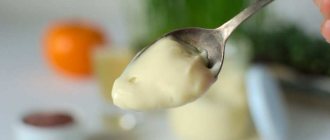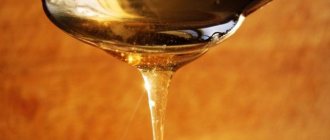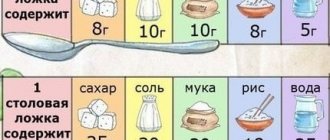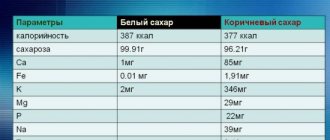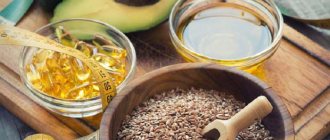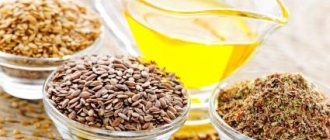Sugar is often called the sweet killer for a number of reasons, but one of the most important is, of course, extra pounds. With the help of sugar, they gain weight at an incredible speed, because sugar is one of the most high-calorie foods along with boiled rice, white bread sandwiches and flour products. How many calories are in a teaspoon of sugar? Let's look into this issue!
How many kilocalories are there in a teaspoon of sugar? Granulated sugar: energy value
Almost every person consumes sugar in everyday life. In its pure form, of course, no one will crunch on such white crystals, but sweetening tea or coffee, adding it to dessert, porridge or other treats is simply a necessity.
It is impossible to do without sweets completely. But in order not to harm yourself and gain weight, you need to know what the calorie content of such a product is. One teaspoon weighing 8 grams contains 32 kilocalories. But in a tablespoon, the nutritional value of crystalline sugar will be 2.5 times greater - approximately 100 kilocalories
If such a sweetener is used for baking, then, as a rule, it is measured out in glasses. One glass with a nominal volume of 250 ml holds about 200 g of sugar. The nutritional value of such a serving of granulated sugar is almost 800 kilocalories.
On a note! Granulated sugar is made from beets or cane. This sweet contains carbohydrates that are quickly absorbed and saturate the body with energy. After sucrose is broken down, glucose is produced.
Granulated sugar extracted from cane is not purified, which makes the product much healthier than beet sugar. But the energy value of such products is practically the same.
Experts note that consuming sugar within reasonable limits will never lead to obesity. What is its daily norm?
Important! Representatives of the fair half of humanity can eat no more than six spoons of granulated sugar per day, and men - no more than nine.
But keep in mind that we are not just talking about granulated sugar in its pure form. This product is found in pasteurized juices, all kinds of carbonated drinks, desserts and other sweets. So, in one bottle of soda there are about 10 teaspoons of sugar.
Sugar – benefit or “white death”?
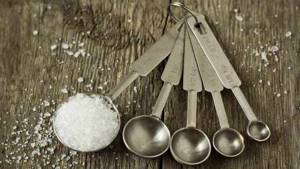
Scientists have calculated that if you regularly eat granulated sugar in large quantities, and even add all kinds of sweets to it, then no one is immune from obesity. Therefore, in order to maintain your health, it is better to give up sugar or reduce its consumption to a minimum.
In general, does crystalline sugar contain anything useful? The majority are carbohydrates, which are quickly and easily absorbed by the human body. Metabolic processes are activated, and incoming sucrose quickly turns into glucose.
On the one hand, this is certainly good, because we need energy every day to perform even the simplest tasks. But if the number of calories consumed significantly exceeds consumption, excess weight appears, which is sometimes problematic to get rid of.
Granulated sugar, regardless of the variety, does not contain any vitamins, beneficial micro- and macroelements, or mineral compounds. If we talk from the point of view of chemical composition, then this is pure sucrose, which in turn is divided into fructose and glucose.
Of course, sugar gives us strength and charges the body with energy. In addition, eating sweets can activate your brain and improve your mood. They also say that sweet foods are responsible for the production of so-called happiness hormones.
Important! If you can't completely give up sugar, then at least minimize your daily consumption.
As for the harm from this product, it is obvious. We consume granulated sugar every day, not only in its pure form. This additive is found in many foods, mainly in desserts and sweets. Therefore, without knowing it, you can eat sugar in excess of the norm every day. The result is excess body weight or diabetes.
But these are not all negative consequences. Granulated sugar in any form has a destructive effect on tooth enamel. It can cause the development of caries and other oral diseases.
Still, don’t forget about diabetes. Some people are convinced that this is a hoax. In fact, excessive sugar consumption increases blood glucose levels. If energy is not expended, then as a result, glucose will begin to suppress insulin production. It is for this reason that diabetes mellitus occurs.
How many carbohydrates are in a teaspoon of sugar. How many calories are in sugar?

The topic of sugar's calorie content is not as clear-cut as it seems. Despite the fact that one gram of any type of sugar (both the cheapest refined sugar and organic coconut sugar) contains about 4 kcal, the human body uses these calories in a completely different way. Ultimately, a teaspoon of honey or coconut sugar is not the same as a cube of table white sugar.
Essentially, what matters is not how many calories are in that teaspoon of sugar, but how the body can use those calories. For example, calories from processed fructose sugar syrup will go into fat stores much faster than calories from natural cane sugar - and neither color (white or brown) nor taste play much of a role.
Sugar calories per teaspoon
If you are used to drinking tea or coffee with sugar, remember that a level teaspoon of sugar contains approximately 20 kcal, and a heaped teaspoon of sugar contains about 28-30 kcal. Unfortunately, when you add two full tablespoons of white table sugar to your coffee, you're not just adding 60 calories to your daily diet - you're dramatically switching up your metabolism.
Once in the stomach, sugar dissolved in liquid is absorbed as quickly as possible and enters the blood in the form of glucose. The body understands that a quick source of energy has appeared and switches to using it, stopping any fat-burning processes. However, when the calories of this sugar run out, “withdrawal” begins, forcing you to drink sweet tea again and again.
Calorie content of sugar
Human receptors are capable of experiencing four tastes - salty, sour, bitter and sweet.
But most of us have preferred sweets since childhood. Perhaps things are this way because our primitive ancestors lived in a warm climate and ate preferably fruits growing on trees. But modern man has replaced fruits with sweet cookies and candies. Where did such a familiar thing to us as sugar come from?
History of sugar
- Archaeological evidence proves that sugar cane was first domesticated in New Guinea several thousand years BC. Gradually, this culture spread throughout Southeast Asia, China and India.
- 500 BC, Indian craftsmen learned to turn sugar cane juice into small dry crystals and make the first sugar candies by cooling the syrup in a large flat bowl. All this greatly simplified its transportation.
- During the reign and conquests of the famous Alexander the Great , his soldiers returning from India brought home a mysterious “honey powder”. But the Indians themselves preferred natural honey to sugar and did not use it too widely.
- Therefore, in Europe and Russia, sugar became widely known only after the end of the Crusades, in the 10th-12th centuries. By that time, Muslim countries in the Middle East and Asia had already learned how to produce sugar from the Indians and put it on a large scale. Then the first significant batches of “sweet salt” arrived in the northern countries. But the overseas product still remained a luxury.
- Fortunately, at the end of the 16th century, the French agronomist Olivier de Serres discovered the presence of a large amount of sugar in a completely common root vegetable for the middle zone - beets. Over time, this allowed Europe and Russia to produce sugar in huge quantities, making it popular and accessible to the entire population.
- Thanks to the active development of production in the 19th century , this scarce and expensive product turned into a common food ingredient and preservative for winter preparations. And today, many of us can no longer imagine our day without tea with sweets or a cup of sweetened coffee.
There are different types of sugar on grocery store shelves that look slightly different. But in terms of chemical composition they are practically no different. Accordingly, the calorie content in them is approximately the same.
For example, 100 grams of regular granulated sugar contains 398 kilocalories .
Calorie content of sugar per 200 grams
Sugar is often measured out in cups. Accordingly, in a glass that contains 200 grams of sand there will be 796 kilocalories .
Calorie content of 1 teaspoon of sugar
Many of us add sugar to our tea and coffee. And by adding one teaspoon of sugar to the drink, you will increase its energy value by about 16 kcal .
Calorie content of cane sugar
Brown cane sugar is considered healthier than its refined counterpart, but in fact it is also not suitable for dietary nutrition.
Its energy value is approximately 377 kilocalories per 100 grams or 11 kcal per teaspoon .
Some nutritionists believe that unrefined brown sugar may contain unwanted contaminants and is unlikely to be healthier than regular white sugar.
Sugar composition
In the language of chemistry, sugar is called sucrose and is described by the formula: 12C * 11 H2O .
From a dietary point of view, the composition of sugar is quite simple and straightforward: 0% fat, 0% protein and 100% carbohydrates .
Harmful properties of sugar
Despite its widespread prevalence, the habit of sweetening food and drinks is not so innocent. According to many nutritionists, sugar is one of the worst components of the modern diet.
It can have harmful effects on metabolism and contribute to all sorts of diseases.
How exactly does sugar harm our health?
- Sugar does not contain protein, essential fats, vitamins or minerals , but it is high in calories, which may well be unnecessary.
Sugar is pure energy, and for most city dwellers who lead a sedentary or sedentary lifestyle, it turns out to be too much of it. Accordingly, an excess of sweets leads to extra pounds, obesity and all related health problems. - Sugar is bad for your teeth . This is explained by the fact that it provides easily digestible energy not only to the person himself, but also to harmful bacteria in his mouth.
- Excess sugar can be bad for the liver .
The fact is that in the body this carbohydrate is broken down into two substances - glucose and fructose. And fructose is metabolized exclusively in liver cells. There is nothing wrong with this - it is a healthy process as long as the amount of the substance remains moderate. However, excess fructose overloads the organ and can lead to fatty degeneration. It is worth noting that it is almost impossible to overeat fructose when getting it from fruits, but this can easily happen if you overindulge in sweets for a long time. - Sugar increases the risk of diabetes . Scientists have found that its excess can cause resistance to the hormone insulin, which can lead to the development of serious diseases. For example, statistics show that people who drink sugary drinks are more likely to develop type 2 diabetes.
- Sugar is highly addictive because it causes a powerful release of the pleasure hormone - dopamine. None of the natural products can cause even the semblance of such an effect. This is why for people prone to addiction, limiting their consumption of sugar can be very difficult - sometimes it is easier for them to give up sweets altogether.
The benefits of sugar
Despite the desire for slimness and a healthy lifestyle, the average modern person consumes about 24 kilograms of sugar per year. Therefore, many scientists are trying to thoroughly study the positive and negative effects of this popular dietary supplement.
To date, research has convincingly proven that sweets are far from a harmless indulgence. So is a product familiar to all of us really an absolute evil? Fortunately, this is not entirely true.
Although sugar, if consumed in excess, can cause excess weight and other problems, in reasonable quantities it can bring undoubted benefits:
- Sugar is a source of instant energy and can support the body in case of extreme fatigue.
- People who periodically suffer from low blood pressure are advised to carry sugar cubes with them. At the right moment, this sweetness will help you quickly raise your blood pressure and feel better.
- The brain definitely requires glucose to function effectively (although too much of it doesn’t have the best effect here either). Otherwise, you may feel distracted and nervous.
- Sugar can cheer you up and lift your spirits. And in some cases, this turns out to be more important than following a diet.
How much sugar can you consume per day?
Sugar, of course, has its rightful place in your diet, but many health and diet experts warn that consuming too much of it can lead to a number of serious complications and diseases.
To maintain your figure and health, scientists advise not to abuse sugar.
Women are recommended to consume no more than 100 calories per day, which is 6 teaspoons or 24 grams.
Men can afford 150 “sugar” calories per day, which corresponds to 9 teaspoons or 36 grams.
Of course, it is worth considering not only the sugar that we personally pour into tea and coffee, but also baked goods, sweets, sweet soda, etc.
Conclusion
Many generations of people around the world have consumed sugar as part of a completely healthy and balanced diet. And although there is an opinion that it should be completely excluded from the diet, it has not yet received scientific confirmation.
As the medieval physician and philosopher Paracelsus rightly noted, it’s all about the dose. It is very important to eat so that the body receives a sufficient amount of energy and carbohydrates, but do not forget about a sense of proportion.
PreviousNext
Source: https://moyafigura.com/kalorijnost-saxara/
How many calories are in a teaspoon of coffee. Calorie content of main types of coffee
Many people know that coffee can be made not only in its pure form; there are its varieties, which also differ in composition. Accordingly, the nutritional value of each type has some differences. In order to understand this, you should consider the most famous types of this drink:
- NATURAL COFFE. Real black coffee beans are a drink with little nutritional value. 100 ml of this drink contains 1-2 kcal. This means that one 200 ml cup of coffee contains 4 kcal. But only a natural product contains this calorie content; if you drink it with milk or granulated sugar, then the nutritional value will be higher;
- GROUND COFFEE. This drink does not harm body weight. A 200 ml cup of drink has 2 kcal;
- INSTANT COFFEE. This type of drink is quite high in calories. There are about 6-7 calories in 100 ml of instant coffee. An 8-ounce cup contains 14-17 calories. Moreover, if you add 1-2 tablespoons of sugar, its consumption may negatively affect your body weight;
- AMERICANO. This type of coffee contains espresso and water. Accordingly, the calorie content of the drink is not very high - 450 ml of the drink contains approximately 15 kcal;
- LATTE. It is served with milk, foam, espresso and no sugar. It is milk that gives it its high calorie content. A standard serving of the drink contains about 250 calories;
- CAPPUCCINO. The drink contains espresso, sugar and cream, which give it increased calorie content. A 150-180 ml portion of the product contains about 210 kcal;
- MOCCACHINO. This is a fairly high-calorie product. It contains espresso, chocolate, chocolate syrup, sugar. It is also served with milk, and sometimes caramel can be added instead of sugar. A standard cup contains approximately 290 calories. For this reason, it should not be included in the diet;
- GLASS. This is a very tasty product to which ice cream is added. One serving without sugar contains about 125 kcal;
- FRAPPUCINO. It is the most high-calorie, served in a large mug or cup, which contains 400 kcal;
- RAF COFFEE. It has a vanilla-milk taste. One 150 ml cup contains 135 kcal;
- COFFEE THREE IN ONE – with milk powder, sugar. The weight of the bag is 20 grams. ½ of the packet is sugar. 10 grams of sugar contains approximately 40 kcal. Powdered milk contains 30 kcal. The total calorie content of one serving of coffee with milk and granulated sugar is 72.
About calories per spoon of cane variety
The nutritional value of cane sugar is slightly less than standard white sugar, so the following calorie indicators are distinguished here:
- a tablespoon contains only 20 g and 75 calories,
- teaspoon – this is from 20 to 30 kcal of cane sugar,
- the reduced amount of calories lies in the composition - there are more minerals, so it is better to give preference to the cane variety rather than the white one.
You should not use cane sugar in excessive quantities, thinking about possible weight loss.
How many calories are in salt
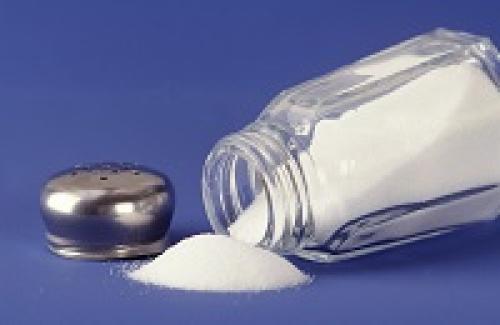
Salt is perhaps the only product that does not contain calories. At the same time, the benefits of salt are quite great:
- Without salt, our body simply cannot exist. It is found in tears, blood and sweat. In addition, the body does not “know how” to synthesize sodium on its own, which means that moderate salt consumption is simply necessary for life;
There are 0 calories in 100 grams of salt.
- Salt is one of the most sought after spices that adds flavor to foods and dishes.
Experts recommend using sea salt, as it is produced through the natural evaporation of water, without adding chemical elements. This means that nutrients and microelements are preserved in salt.
Daily sugar intake for women and men
In accordance with WHO standards, the percentage of calories that enter the body with sugar should be no more than 10% of the total. For men, this sweetener norm is up to 9 teaspoons, for women – 6.
But this number needs to take into account more than just the number of teaspoons of sweetener that have been added to drinks or certain dishes. You need to count the amount of sweetener in all food eaten per day. For example, a glass of a sweet carbonated drink with some sweets can pay for the entire daily requirement in one go.
How many grams of sugar are in a teaspoon. How many grams of salt, sugar and flour are in a tablespoon
Unfortunately, not every housewife has accurate kitchen scales in her kitchen. In addition, measuring the weight of food is much faster and more convenient using various types of kitchen utensils. For example, many housewives are interested in how many grams of salt are in a tablespoon, as well as sugar, flour, etc.
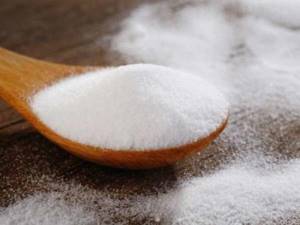
When talking about the weight of food in a spoon, they usually assume a spoon with a small heap. Most recipes call for just this measurement.
How many grams of salt and sugar in a tablespoon
So, how to measure bulk and liquid products using this kitchen accessory? When preparing a dish according to any recipe, it is worth keeping in mind that one tablespoon contains:
— sugar — 20-25 g;
— “Extra” salt — on average 25 g;
- regular coarse salt - about 30 g;
- powdered sugar - 25 g.
As you can see, the answer to the question of whether 1 spoon is how many grams of salt or sugar depends, among other things, on the degree of grinding of the latter.
How much flour is in a spoon
This product is not measured with spoons very often. Usually a glass is used for this purpose. But sometimes tablespoons are also used to measure flour. For example, this can be useful when preparing some kind of sauce.
A tablespoon contains about 25 g of flour. Its weight in a glass is 160 g. Such figures are correct for both wheat and soy flour.
Weight of other products
So, we found out how many grams of salt are in a tablespoon (as well as sugar and flour). But of course, other products can be measured in a similar way. Very often the recipe calls for exactly the same amount of other products. This could be, for example:
- water - 18 g;
— citric acid — 14 g;
- soda - 25 g;
— vegetable oil — 16 g;
- cinnamon - 18 g.
As you can see, the weight of food in tablespoons can vary. But for bulk products this figure is usually an average of 25 g.
Composition of nutrients, BJU
| For quantity: 1 teaspoon | ||
| Calories – 18 | Calories from fat – 0 | |
| BJU | ||
| Total fat content | 0.01g | |
| Saturated | 0g | |
| Polyunsaturated | 0.01g | |
| Monounsaturated | 0g | |
| Cholesterol | 0mg | |
| Total carbohydrate content | 4.55g | |
| Dietary fiber | 0g | |
| Sugar | 4.24g | |
| Squirrels | 0.01g | |
| Vitamins and microelements | ||
| A – 0µg | C – 0mg | |
| B-6 – 0 mg | B-12 – 0µg | |
| D – 0µg | E – 0 mg | |
| Calcium 4.5 µg | Iron 0.08 mg | |
| Magnesium 0.95 mg | Zinc 0.3mg | |
| Potassium 13.7 mg | Sodium 0.55 mg | |
Distribution of calories for BJU: | ||
| For quantity: 1 tablespoon | ||
| Calories – 76 | Calories from fat – 0 | |
| BJU | ||
| Total fat content | 0.01g | |
| Saturated | 0g | |
| Polyunsaturated | 0g | |
| Monounsaturated | 0g | |
| Cholesterol | 0mg | |
| Total carbohydrate content | 19.54g | |
| Dietary fiber | 0g | |
| Sugar | 19.15 | |
| Squirrels | 0.01g | |
| Vitamins and microelements | ||
| A – 0µg | C – 0mg | |
| B-6 – 0 mg | B-12 – 0µg | |
| D – 0µg | E – 0 mg | |
| Calcium 7.4 µg | Iron 0.11 mg | |
| Magnesium 1.2 mg | Zinc 0.25mg | |
| Potassium 17.6 mg | Sodium 1.8 mg | |
Distribution of calories for BJU: | ||
| For quantity: 1 heaped teaspoon | ||
| Calories – 31 | Calories from fat – 0 | |
| BJU | ||
| Total fat content | 0g | |
| Saturated | 0g | |
| Polyunsaturated | 0g | |
| Monounsaturated | 0g | |
| Cholesterol | 0mg | |
| Total carbohydrate content | 7.82g | |
| Dietary fiber | 0g | |
| Sugar | 7.66g | |
| Squirrels | 0g | |
| Vitamins and microelements | ||
| A – 0µg | C – 0mg | |
| B-6 – 0 mg | B-12 – 0µg | |
| D – 0µg | E – 0 mg | |
| Calcium 2.96 µg | Iron 0.04 mg | |
| Magnesium 0.48 mg | Zinc 0.1 mg | |
| Potassium 7.04 mg | Sodium 0.72 mg | |
Distribution of calories for BJU: | ||
| For quantity: 1 teaspoon | ||
| Calories – 17 | Calories from fat – 0 | |
| BJU | ||
| Total fat content | 0g | |
| Saturated | 0g | |
| Polyunsaturated | 0g | |
| Monounsaturated | 0g | |
| Cholesterol | 0mg | |
| Total carbohydrate content | 4.59g | |
| Dietary fiber | 0g | |
| Sugar | 4.56g | |
| Squirrels | 0g | |
| Vitamins and microelements | ||
| A – 0µg | C – 0mg | |
| B-6 – 0 mg | B-12 – 0µg | |
| D – 0µg | E – 0 mg | |
| Calcium 0.55 µg | Iron 0.02 mg | |
| Magnesium 0.09 mg | Zinc 0mg | |
| Potassium 1.33 mg | Sodium 0.14 mg | |
Distribution of calories for BJU: | ||
Why sugar is prohibited in diets
With a properly balanced diet, 30% of carbohydrates in the human body are modified into fats. If you abuse sweets, this figure increases. For reference, the calorie content of a 25 g spoon of sugar is 100 kcal. Therefore, sugary foods are excluded from the diet in many diets, especially reduced diets (obesity, atherosclerosis) and diabetic ones.
The energy value of carbohydrates needs to be known in order to control their consumption. An excess of sweets contributes to metabolic disorders, while a deficiency leads to hypoglycemia.
